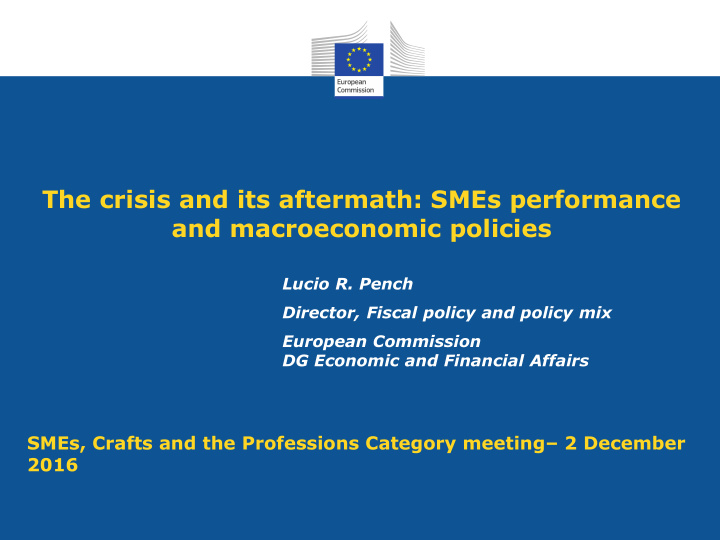



The crisis and its aftermath: SMEs performance and macroeconomic policies Lucio R. Pench Director, Fiscal policy and policy mix European Commission DG Economic and Financial Affairs SMEs, Crafts and the Professions Category meeting – 2 December 2016
Recovery remains fragile, with slack in the economy Euro area GDP: annual growth Employment, total hours rate and cumulative change, worked, euro area 2008-18, 102 index, 2008-Q1 = 100 100 98 96 94 92 90 08 09 10 11 12 13 14 15 16 Employment Total hours worked
Small and medium-sized enterprises (SMEs) in Europe • SMEs form the backbone of the EU28 economy. • In 2015, just under 23 million SMEs generated € 3.9 trillion in value added and employed 90 million people. • They accounted in 2015 for two thirds of EU28 employment and slightly less than three fifths of EU28 value added in the non-financial business sector. • The vast majority of SMEs are micro enterprises with less than 10 employees – such very small firms account for almost 93% of all enterprises in the non – financial business sector. 3
Effects of the economic crisis on SMEs and their recovery
Firm growth can be associated with productivity growth Figure: Labour productivity growth in EU industry by size class (N of persons employed) 2008-2014 Source: Single market integration and competitiveness report 2016, based on Eurostat data 5
Factors affecting SMEs' size and growth • Factors that are critical for SMEs growth include their capital intensity, investment rate, access to finance, availability of high-quality workforce, etc. • These factors are sensitive to economic policy. Research shows that some structural reforms can have a significant impact on SMEs' growth rate. • The design of public policies matter: their impact is different according to the size of the firm. • Policies recommended in the European Semester and the Juncker Investment Plan should help increase the shares of fast growing SMEs. 6
Three fiscal stances 7
Public spending becoming less growth-oriented a) 2014 b) 2000 14.97% 16.25% 55.35% 56.54% 27.21% 29.68% Long-term spending Other spending Long-term spending Other spending Welfare spending Welfare spending 8
Diverse situations across MSs and diverse responses Euro area Fiscal Map 9 Note: Based on COM forecast, S1 to measure consolidation needs, 2016 output gaps for good/bad times
Accommodative monetary policy in the euro area Short- and long-term market rates ECB policy rate, Eurosystem BS size % 6 4 200 index % 5 ECB deposit facility rate 190 EONIA rate 4 3 180 forecast Eurosystem BS size (Jan 2010=100) 3 170 2 2 160 1 150 0 1 140 -1 130 -2 0 120 -3 110 08 09 10 11 12 13 14 15 16 17 18 Short term Long term -1 100 Short term (real) Long term (real) Jan-10 Oct-10 Jul-11 Apr-12 Jan-13 Oct-13 Jul-14 Apr-15 Jan-16 Oct-16 Source: IHS, ECB, Commission services Short term rate: 3M Euribor; Long term rate: 10Y interest swap; 10
Credit provision to private sector supported by ample liquidity and low financing costs M3 & Credit Growth Composite credit cost indicators (CCCIs) 7 (last obs. October 2016) 15 CCCI of HHs CCCI of NFCs 6 % MFI loans to the Private Sector (YoY) 12 5 M3 YoY SA 9 4 6 3 3 2 0 1 Last observation : September 2016 -3 Sources: ECB, Bloomberg, IHS, DG ECFIN calculations Jan-05 Jan-07 Jan-09 Jan-11 Jan-13 Jan-15 0 2004 2006 2008 2010 2012 2014 2016 Source: ECB 11
Receding financial fragmentation among countries and companies Country-specific CCCIs for NFCs Interest rate spread on small (SMEs) and large loans to NFCs Coefficient of Variation* (STDEV/AVG, 3M mov avg.) 8 % 45 350 bps DE FR 40 300 7 IT ES 35 250 PT NL 6 30 200 5 25 150 20 4 100 15 EA Spain 3 50 10 Italy Germany 2 5 0 Jan-10 May-10 Jan-11 May-11 Jan-12 May-12 Sep-12 Jan-13 May-13 Jan-14 May-14 Jan-15 May-15 Jan-16 May-16 Sep-10 Sep-11 Sep-13 Sep-14 Sep-15 Sep-16 Note: * Based on available data for 9 EA countries 1 0 2008 2010 2012 2014 2016 Source: ECB, Bloomberg, BofA ML, DG ECFIN calculations 12
Background graphs
Frequency of multiple investments by funds in the same company (2010-15) START-UP SCALE-UP 57% 60% 42% 40% 33% 31% 25% 20% 12% 0% 1 round 2 rounds >2 rounds US EU Source: Preqin Venture Capital database as quoted in Duruflé, Hellman, Wilson (2016) • The figure shows the frequency of multiple investments in EU compared to the US. • In the EU start-ups do receive financing, but less of them received investments in following rounds, which is essential for their scale-up. • Scale-ups need PATIENT venture capitalists. 14
The European Union supports SMEs across different areas • Improving SMEs access to finance : CMU, Investment Plan, Fund-of-funds, COSME. • Supporting SMEs innovation activities: H2020, clusters, KETs, public procurement for innovation, DSM, IPR. • Facilitating access to markets : SMS, DSM, public procurement, Enterprise Europe Network. • Reducing regulatory burden : SMS, DSM, REFIT. • Creating a business friendly environment : SBA, entrepreneurship action plan, insolvency and second chance, European Semester. • Easing access to skilled workers/ talent : skills agenda. 15
Recommend
More recommend